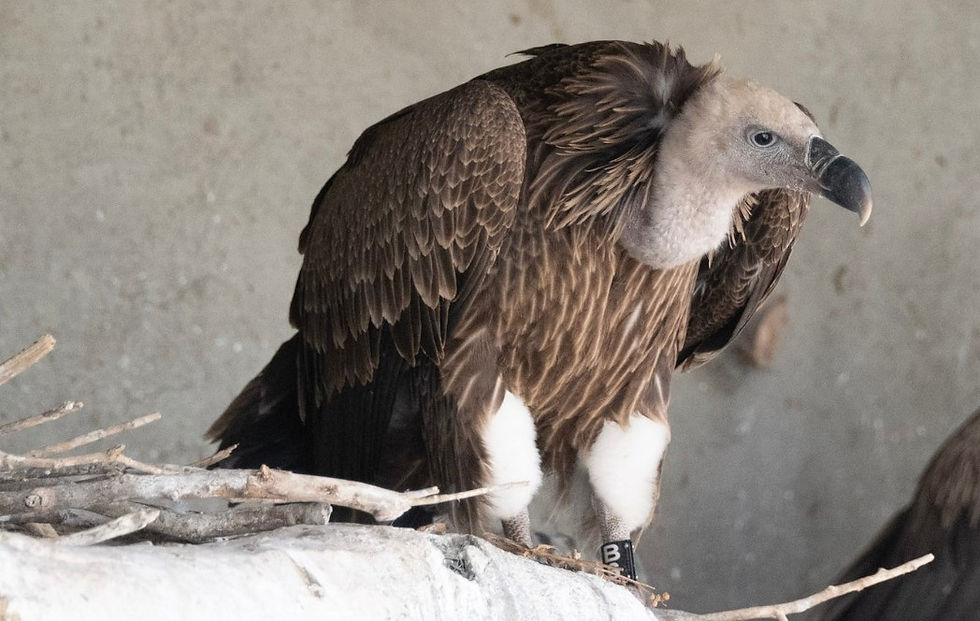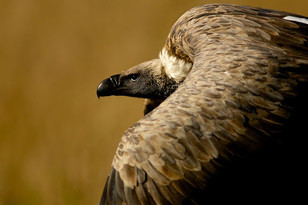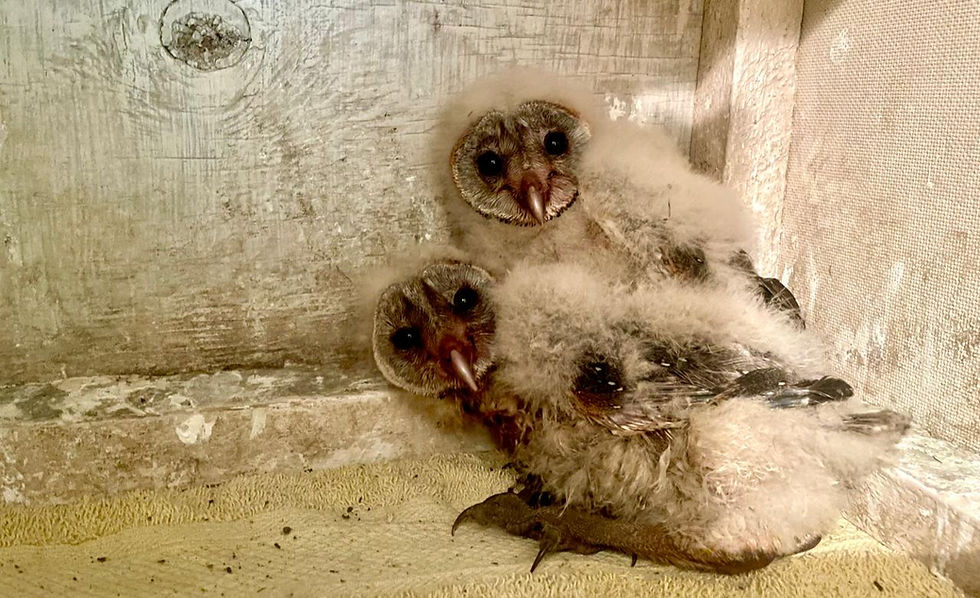Tips and tricks on how to age a Rüppell’s Vulture
- Shiv Kapila

- Sep 13, 2022
- 5 min read
Updated: Sep 14, 2022
Following on from our live show on Vulture Awareness Day last weekend, we’d like to delve deeper into how to identify one of our more commonly encountered large Vultures – the Rüppell’s, and how to accurately age individual birds. We’re ‘blessed’ with a handful of captive Rüppell’s, who are all in different stages of their development into adults.
Rüppell’s vs. White-backed vultures:
Seen alone, juvenile Rüppell’s and White-backed's are very similar. Both will have a jet-black bill and eye (although in rare exceptions, a juvenile White Backed can have a light bill, likely through hybridisation); this is where the similarities end thankfully – Rüppell’s are much larger and have a longer bill and skull. As they age, they diverge in appearance even more. The White backed will develop a white patch on its back, it’s feathers will turn paler, but it will retain the black bill and eye,
whilst the Rüppell’s will develop a scaly appearance with a light bill and eyes.
Left: A juvenile (pre-fledged) Whited-backed vulture – note the black bill, black eye, and lanceolate feathers. All very similar to the juvenile Rüppell’s vulture on the right.
In the adult White-backed vulture the black bill and eye remain, though the lanceolate contour feathers are replaced by uniform brown-grey feathers with black flight feathers.
Note these adult White-backed vultures retain the black bill and eyes.
Key changes in Rüppell's Vulture's feathers, ruff, eyes and bill as it ages
As a Rüppell’s vulture ages, it will transition through a series of plumages and other changes to its eye and bill. Overall changes through the years:
Feather shape (drawing left): from long, narrow, pointed (a) to rounder and shorter (b)
Ruff (drawing right): from lanceolated (a) via a disintegrating mix to a powder puff (b)
Eyes: from black (a) to brown to yellow (b)
Bill: from black to pale-tipped to ivory coloured
Source: An ageing guide for the Cape Vulture (1988) - the development of Cape Vultures is very similar to that of Rüppell's vultures
The Juvenile Rüppell’s – fledgling to 2nd year
All the contour and flight feathers on a juvenile are pointed, and this feature is particularly conspicuous for the last row of upper wing coverts, which are both pointed and broadly tipped in white (left drawing a). The white tips appear as a thin white line along the wing and this line is visible, under good atmospheric conditions, from a distance of hundreds of metres. These feathers appear to have a paler palette along each central feather shaft.
There is a conspicuous bare patch at the rear base of the neck and there is a pronounced ruddy ruff comprised of long and floppy lanceolate feathers (right drawing a).
The chest and belly appear broadly streaked, and overall the juvenile has a darker appearance than an adult.
The bill and the eyes are black

Immature Rüppell’s – 2nd-4th year
At this age the back feathers are mostly dark, pointed with a central white rib and having the tip "dipped as if in white", but newIy moulted ones from the end of the second year are round with a broad white edging.
The ruff starts to look very messy – the long lanceolate feathers mixed in with finer white feathers.
It is estimated that this age class extends from three quarters of the way in the second year after fledging to the end of the third year, though this is variable; the head, neck and ruff are similar in appearance to those of the juvenile, but with finer white feathers appearing.
The eyes are still dark but the bill starts to turn pale, beginning at the tip.

Sub-Adult Rüppell’s – 5th to 7th year
After the moult towards the end of the fourth year, all new feathers are conspicuous because they are well rounded without the white tips but instead have a broad white edging.
The ruff starts to disintegrate rapidly to the adult state
The bill is now almost completely ivory coloured, and the eyes have lightened noticeably.

The photo below shows a subadult (top), with a semi-pale bill, the beginnings of the scaly contour feathers, and a ruddy ruff with lanceolate feathers mixed with fine white feathers. A young adult (bottom), with an almost completely pale bill, clear-cut scaly body feathers, and full white ruff.

Adult Rüppell’s – over 8 years
The full adult plumage is attained in the seventh year, and continues to become more clear-cut over the next 2-3 subsequent moults. Eyes and bill are now yellow and ivory respectively.



Personality changes in captive birds
Having a unique experience of housing and interacting with several age stages of three of our large vulture species (Lappet, Rüppell's and White-backed), I would be remiss if I didn’t mention their characters – after all, these are long lived birds, and it stands to reason that they think, form relationships, and therefore have their own personalities, both on a species and individual level.
Lappet-faced Vultures are initially very timid and shy, but often ‘turn a corner’ once realising they are safe and cared for; they become much more social, though they’re calm, and keep to themselves. Before socialising, they need a formal introduction, but then are very keen to engage in a bout of tug-of-war. They keep order in the enclosure by enforcing rules and decorum.
White-Backed Vultures almost never tame in captivity – they remain aggressive and are always willing to fight and attack their handlers. Visitors to the Naivasha Raptor Centre will be glad to know that they will never be asked to interact with any White-backed vultures at all. I have been severely injured by White-backed's that had grave injuries, and were also assumed to be weak and/or sedated.
Rüppell’s Vultures readily tame as captive birds – they recognise the added security and reliable food source that captivity provides. They are a sociable, communal and gregarious species that thrives on company – vulture or human. All of our captive birds become ‘friends’ after a month or two after joining the flock – this may be a reflection of their intelligence. We don’t discourage this behaviour with our permanent resident vultures as a happy, comfortable and confident bird is more likely to breed in captivity, thereby helping with the conservation of their species in the wild. This fact also makes them excellent education birds.
Juvenile vultures are almost always more boisterous than adults – they have a teenager mentality, and get up to a lot of mischief. Adults are calmer and are much more gentle. This may be an ingrained trait where they feel that they have more to lose by being aggressive and starting fights. This would stand to reason especially if they have young – the loss of a parent has a far-reaching consequence in that it often leads to the loss of a young one.
Support our work
You can now support Yusef with a monthly donation and help us pay for his care which includes food, enclosure maintenance, enrichments, medical care and salaries for staff to feed them and clean the enclosures. Or make a donation and support one of our programmes or select the option Area of greatest need which provides us with unrestricted funding that can go to where we believe it is needed most, as fast as possible. Every single donation helps us to achieve our mission to understand, protect and restore raptor populations in Kenya.

Wish to learn more, visit our website and join us on Facebook and Instagram.
Kenya Bird of Prey Trust
Understand - Protect - Restore















Comments